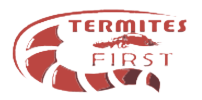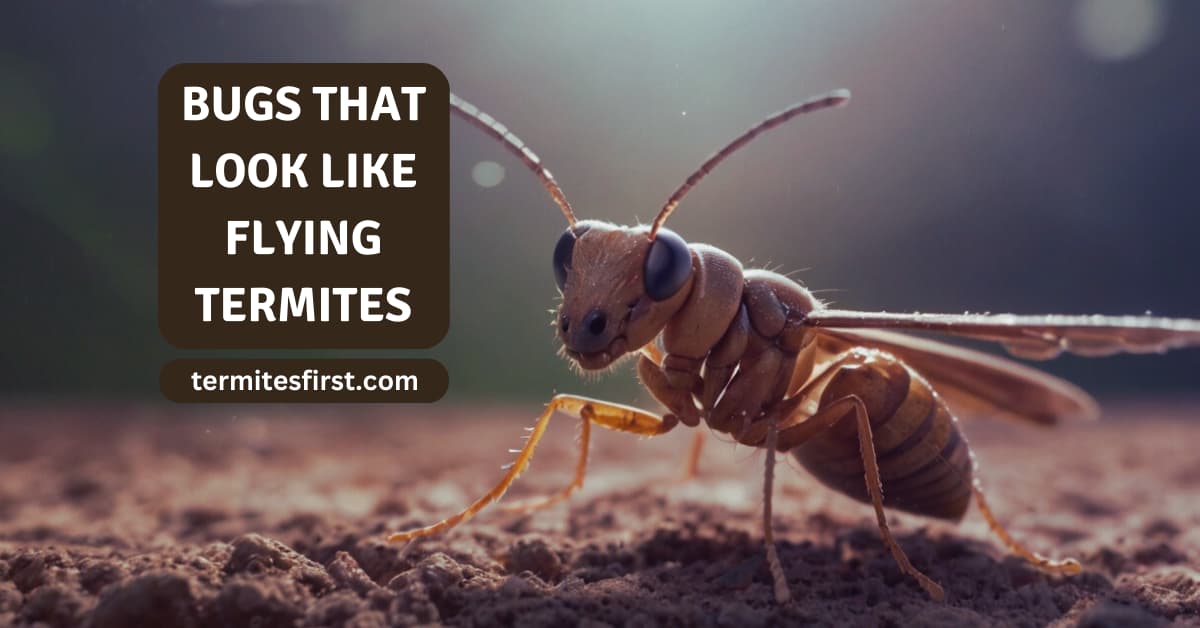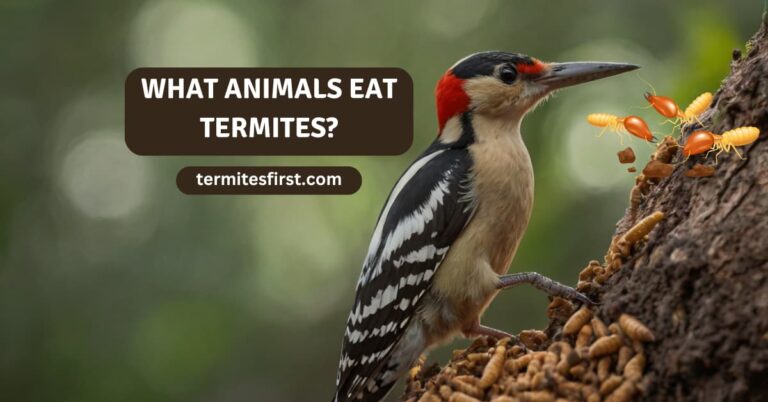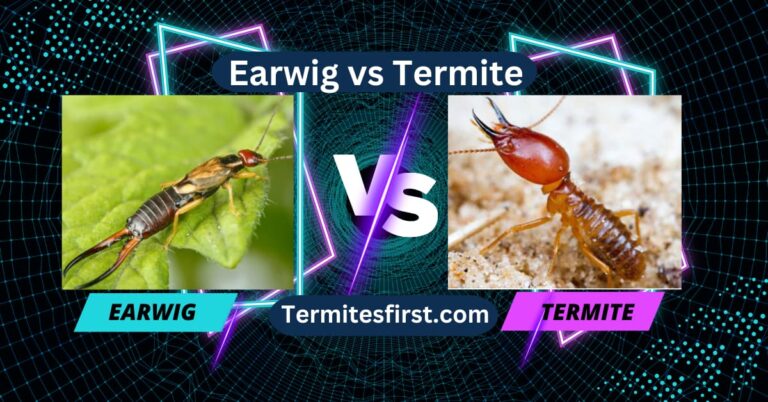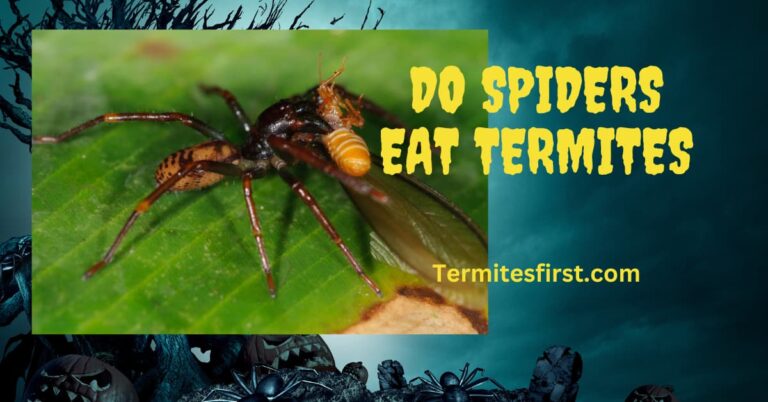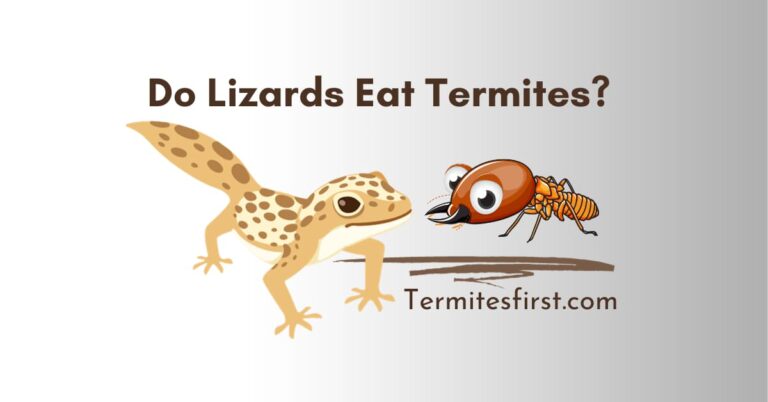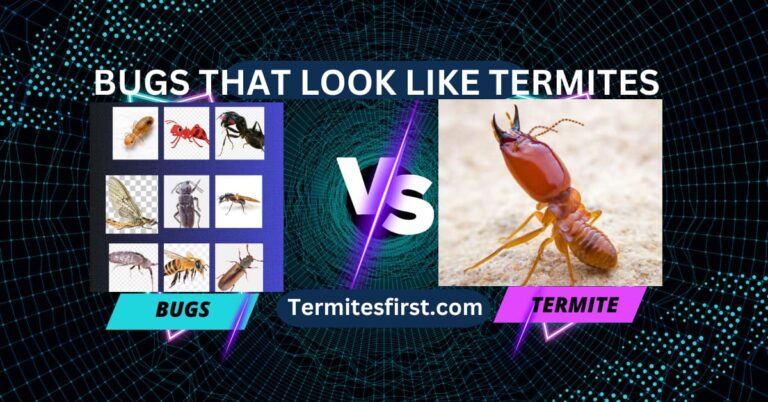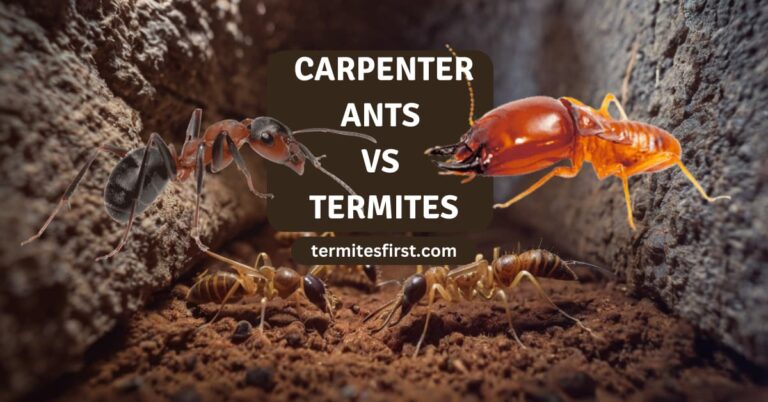Bugs That Look Like Flying Termites and How I Identify Them
Seeing insects that resemble flying termites for the first time can be a shocking experience. These winged insects frequently swarm in large numbers, usually following a rainstorm, and can be easily mistaken for termites upon first glance.
They do have some notable differences, including body form and wing morphology. Knowing these differences is key to being able to identify them correctly. Watching what they do and where they live gives definitive hints.
Witnessing the beauty of these insects inspires us to approach pest control with confidence, making smart and informed decisions.
Main Insights:
- Flying termites are perhaps the most important sign of a termite colony’s presence and identifying them is key to successfully protecting your home from these pests. They often swarm in the spring and fall, acting as a warning sign calling for urgent action.
- You can tell termites apart from similar pests by their larger size, lighter color, and especially their unevenly veined, straight wings. Their most striking physical features are their broad thorax and body that is all one color. When they invade wood structures, they tend to make wood sound hollow.
- Many pests are mistaken for flying termites, including carpenter ants, powderpost beetles and flying ants. Knowing their differences, like their wing structure and shape of their antennae, is crucial to preventing a big misidentification.
- Watch for warning signs of subterranean termites. Swarmers, shed wings, damage to wood, mud tubes, and even strange sounds coming from your walls can be signs of an infestation. Keeping a watchful eye with regular inspections can help catch an infestation early on, preventing costly and severe damage.
- Termites are notorious for destroying wood that has been compromised, particularly in humid conditions. These are the areas homeowners should most closely inspect and look to take preventative actions to preserve them.
- When it comes to infestations, timely intervention and professional pest control services are advised. With proper maintenance, moisture control and guidance from a pest management professional, you can greatly lower the threat of termite destruction.
Flying Termites
Flying termites, known as swarmers, play an important role in the termite colony. These are the sexually mature ones that are responsible for reproduction and establishment of new colonies. These swarmers will be the future kings and queens of their colony.
Though they don’t cause damage directly, their appearance can indicate that an infestation exists. In Indonesia, that warm climate means termites are active year round. Identifying these swarmers is the first step to proper pest management.
Seeing them in your home or near your house can mean there’s a current termite infestation, or that your home is at risk of an infestation.
Seasonal patterns are a major factor in termite swarming behavior. Swarmers often appear under warm and humid conditions, most commonly following rainfall. This timing matches up nicely with their need for moisture, which helps them survive and successfully establish new colonies.
Identifying these seasonal patterns is key for homeowners looking to stop infestations before they start.
Basic Facts About Termites
Termites are usually between 1/4 inch and 1/2 inch long. Their pigmentation can be brown, white or black, again depending on the species. Determining which kind of swarmer you have is simple if you look closely at their wings.
They have two pairs of wings that are of equal length, an important characteristic for identification. These wings are white and/or translucent with a veiny structure that makes them easy to identify and different from most other flying insects.
Appearance of Termites
Termites are very easy to identify by their broad thorax and body. In contrast to ants, termites lack a narrow waist. Another important characteristic is the presence of two pairs of wings.
When checking wood structures, a hollow sound will alert you that termites may be present and require further examination.
Social Behavior and Habitats
A termite colony is one of nature’s most intricate social systems. Each colony is made up of castes such as workers, soldiers, and reproductives. Since flying termites are the colony’s reproductives, they are the key to the colony’s lifecycle continuing.
Their ideal living spaces are damp, humid areas, because they need to be in a humid environment to live. They play an important role in how they interact with their environment by consuming cellulose, essential to their diet.
This interaction can cause extensive destruction of wooden infrastructure in urban landscapes.
6 Bugs That Look Like Termites
Bugs that look like flying termites can really raise a ruckus. Most folks are understandably concerned about the damage termites can cause. These pests, which look similar to termites, cause a lot of misidentifications and mistaken alarm. Just learning to tell these common lookalikes apart from real termites can save you thousands in extermination and repair costs.
Identifying the key characteristics, such as size and color, is key. It empowers you to do the right thing with pest control.
Carpenter Ants Overview
Carpenter ants are frequent imposters, as they can be easily mistaken for termites. They are usually 1/4-inch to 1/2-inch long and have a similar dark color. Get a little closer and you’ll notice their characteristic bent antennae, which distinguish them from the straight antennae of termites.
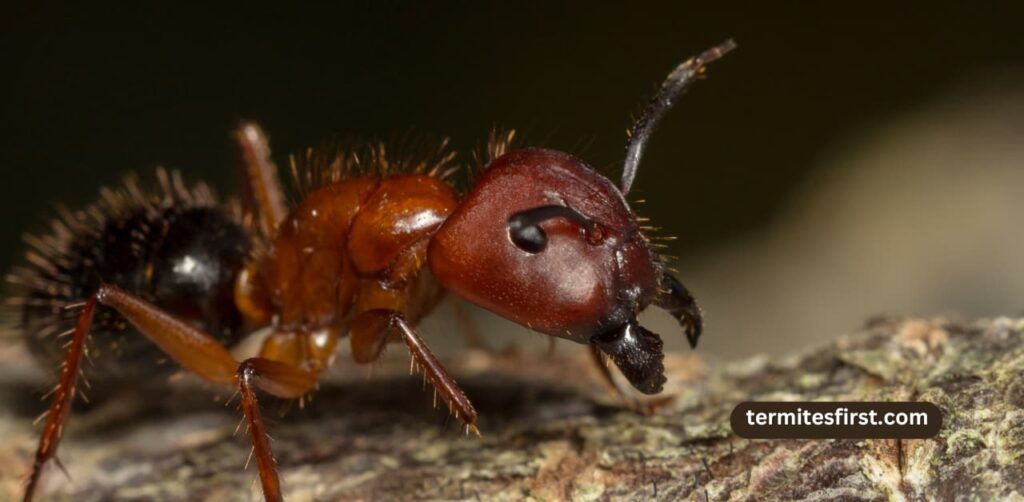
Carpenter ants do not eat wood, unlike termites. Rather than eating the wood, they burrow into it to create their nests and feed on a balanced diet of plant and animal matter. This dietary distinction is important in correctly identifying them.
Powderpost Beetles Overview
Powderpost beetles are a second insect that is frequently confused with termites thanks to their wood-boring tendencies. These beetles are indeed smaller than termites, about 1/8 to 1/4-inch long. They’re responsible for leaving a telltale trail of finer, powdery frass in their wake.
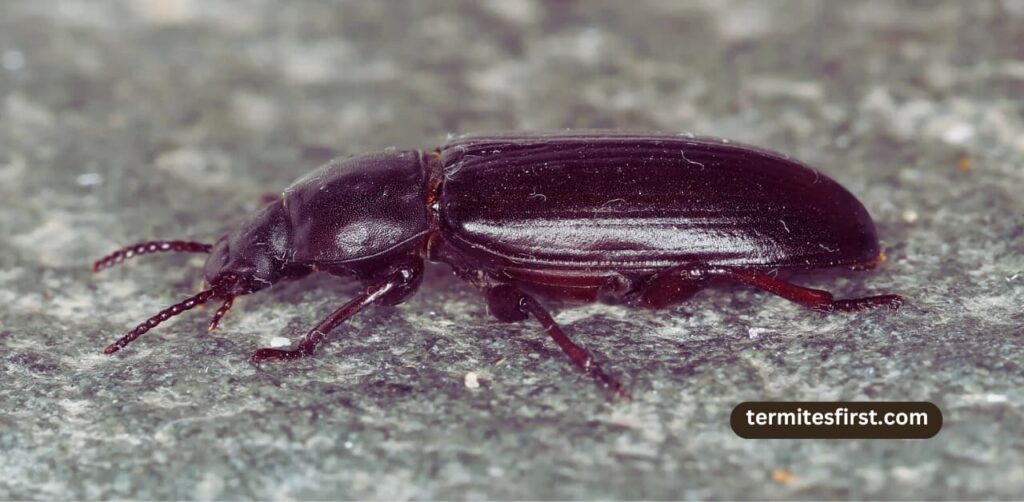
This frass is one of the largest clues to identify them, distinguishing them from termites that often leave behind mud tubes and fecal pellets.
Flying Ants Overview
Flying ants, or ant alates, usually cause the most panic with their termite-like appearances when swarming. Recognizing characteristics such as elbowed antennae and a constricted waist can separate these insects from termites.
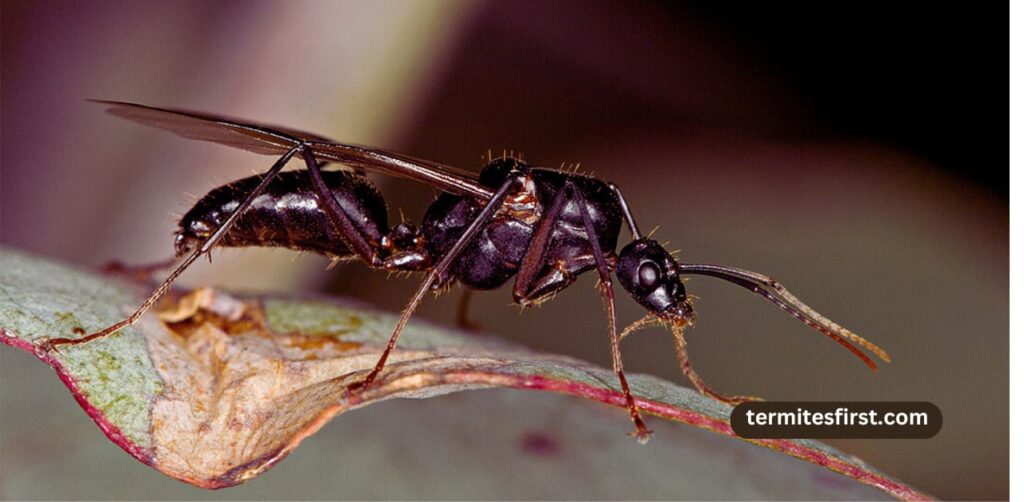
Flying ants only have wings that are unequal in size. This identifying feature is a great way to tell them apart from termite swarmers.
Carpenter Bees Overview
Carpenter bees are large, black and yellow, solitary insects. They are up to 1 inch long, many times the size of the average termite. Unlike termite colonies, carpenter bees like to nest alone, typically forming their nests by boring holes into wood.
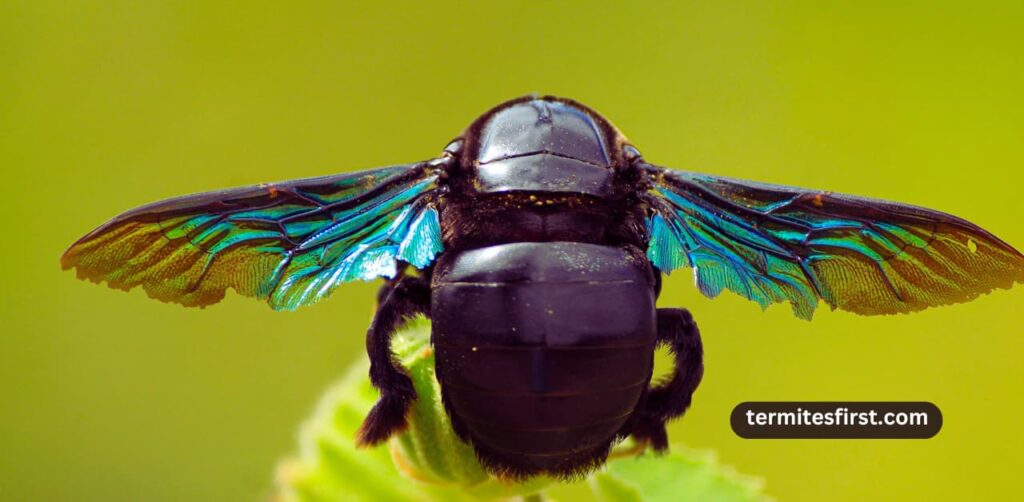
Because of their smaller size and bright colors, they should be easier to identify correctly.
Acrobat Ants Overview
Acrobat ants are much smaller, and their body posture when agitated is quite characteristic. Their unique color pattern and nesting behavior, typically in rotting wood or soil, aid in distinguishing them from termites.
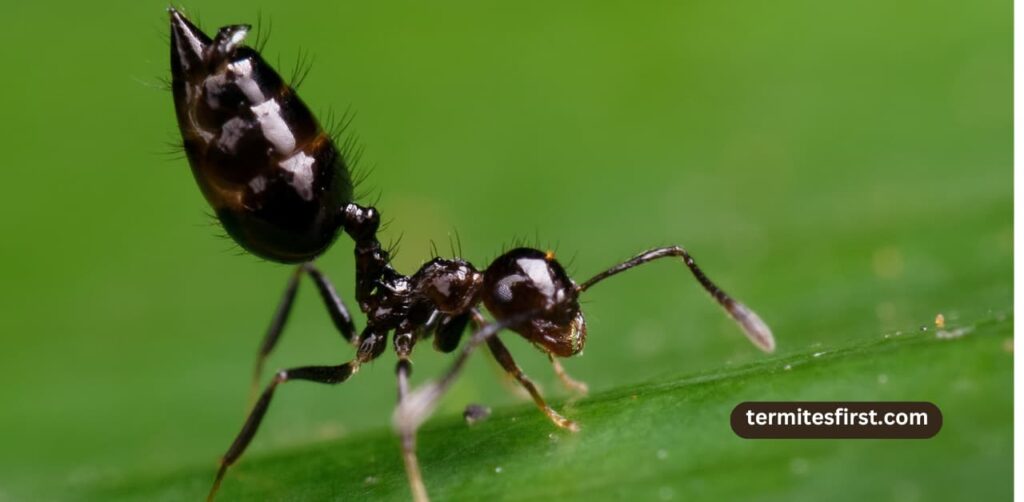
Though they inhabit the same type of environments, their smaller size and more docile behavior are dead giveaways.
Mayflies Overview
Mayflies are ephemeral as adults and have a very similar wing form to that of flying termites. Usually found around water, their environment and short life span make them easy to identify apart from termites.
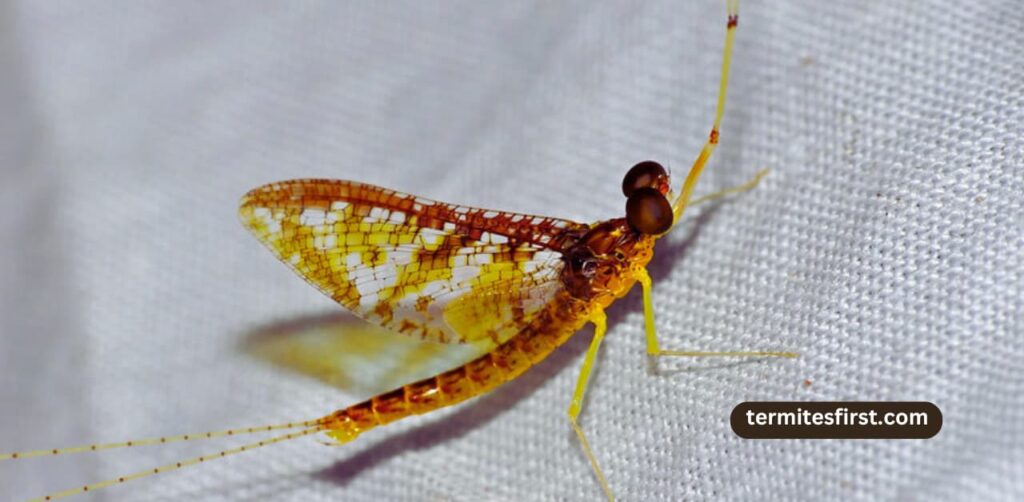
Mayflies, on the other hand, do not have the destructive tendencies of termites and are therefore less worrisome in terms of potential property damage.
Identifying Termites and Lookalikes
Protecting your home starts well before the pest control service arrives. It’s all a matter of knowing the telltale signs to look for and the minute distinctions that will protect your timber investments from harm. When we begin identifying these insects, starting with physical characteristics helps lay down a strong foundation for comparison.
Close observation is key in pest identification! Developing a short checklist of the most essential features can make this process much easier. This checklist is your first line of defense. In a world teeming with numerous other small wood-eating insects, not all of them are doom and gloom!
1. Size Comparison
Making a size comparison chart is a simple way to differentiate termites from lookalikes. Termites range in size from 0.16 to 0.5 inches in length. Another insect that looks like a termite, the Carpenter Ant, is 0.24 to 0.5 inches long.
When IDing specimens, size is a major factor in telling species apart. A small detail can help you determine if you have a termite or something else entirely. For instance, Carpenter Bees are generally much larger up close, allowing easier distinction.
2. Wing Structure Differences
Identification by wing differences is key. Here’s a bullet list to help:
- Wings are equal in length, about twice the body size, and lie flat over the body when at rest.
- Wings are different lengths, with front wings longer than hind wings, and wings are folded back over the body.
- Wings equal in size, if present, with hind wings longer than the forewings.
Identification depends on wing observation, because these structural differences are very obvious.
3. Mouthpart Variations
By looking closely at mouthparts we can understand how these insects ingest food. Termites have relatively straight mandibles well adapted for chewing through wood, while Carpenter Ants have increased biting mandibles well adapted for cutting through wood.
This structure is closely tied to their feeding behavior. For instance, insects such as Silverfish, whose mouthparts are highly specialized to chew starchy materials, exhibit a clear contrast.
4. Body and Antenna Features
Identifying termites involves spotting these key features:
- Termites: Straight antennae and a broad waist.
- Have a distinct narrow thorax, curved antennae, and create smooth tunnels in wood.
- Flying Ants: Constricted waist and bent antennae.
These characteristics are key to determining whether a pest is a termite or not.
5. Color Characteristics
Color provides another helpful hint in identifying these pests. Termites and Carpenter Ants are black or brown. Color can be deceptive as it can change with species and environment.
An example would be if Subterranean Termites live in a damp environment, their color may change, making it important to observe carefully.
Signs of a Termite Infestation
Catching a termite infestation early can save homeowners from significant damage and costly repairs. Noticing signs of these tiny insects, such as visible holes and fine sawdust, as soon as possible can help you take action against termites and reduce their impact on your home.
A simple checklist of signs can be invaluable during a thorough termite inspection, ensuring that you don’t miss any potential evidence.
Presence of Swarmers
Seeing swarmers is one of the most obvious signs of a termite infestation. Winged termites usually come out only when all conditions are right. This typically occurs during the spring or following a rain shower, as they depart from their nests to form new colonies.
While finding a few dozen Formosan swarmers inside a building may not always indicate an active infestation, seeing hundreds certainly does. If you do discover swarmers, get on it immediately! Their presence in your home is a sign of a well-established colony that has taken years to develop.
This is particularly important in areas where Formosan termites are prevalent. Even a treated structure can still be vulnerable.
Shed Wings Evidence
Shed wings are a certain sign of termite activity. These shed wings are often seen stacked up near windowsills, door frames, and other entry points around houses.
So when you do an inspection, make sure you check these areas for wings. Locating these wings is a surefire sign that swarmers are attempting to start a new colony inside the structure.
Wood Damage Indicators
As termites munch their way through your home, they leave a trail of damage signs. The most notable signs of termites include hollowed-out wood, tunnels inside wooden structures, and soft spots in floors or walls.
Regular inspections can help spot these signs early on so you can take immediate action to stop the infestation. Mud-lined tunnels are a clear sign of damage pointing to active infestations.
All of these problems require quick action to avoid lasting damage.
Mud Tube Presence
Mud tubes are one of the main signatures of subterranean termites, including the very damaging Formosan variety. These pencil-sized tubes, constructed with soil and debris, are visible along walls, ceilings, or foundation pieces.
So inspecting for mud tubes is critical. These tubes form a protected route for termites, linking their home to their meals. Any visible tubes should be carefully examined to determine if an infestation is present.
Stuck Windows and Doors
Additionally, termites may weaken the structural integrity of wooden frames causing windows and doors to stick. This happens as the termites eat through the wood, making it swell or warp.
Homeowners should watch their windows and doors like a hawk. Even slight changes could be a sign of serious termite destruction.
Noises from Walls
Termites make a characteristic sound similar to crinkling cellophane while they eat wood. Being aware of these odd sounds while inspecting can lead pest management professionals to hidden infestations.
These noises are usually heard from inside walls or wooden support beams and can signal active feeding, requiring immediate evaluation by a professional.
Common Damage Locations
When we identify insects that resemble flying termites, we must identify where they tend to do damage in our residences. Knowing their common damage locations is key for successful pest management. Other frequent areas are highly neglected storage spaces like basements, attics, garages, and crawl spaces.
Since these spaces are frequently left undisturbed for months, they can be ideal breeding grounds for termites to thrive undetected. Termites are attracted to find cellulose materials to eat. They usually go after storage spaces stuffed with wooden materials, boxes, or document items—all of which make for an incredible snack!
Wood Structures at Risk
In residential settings, there are four main wood components that are often highly vulnerable to termite damage. Support beams, floors, wooden window and door frames, and closets often meet the same fate. The chance for infestation is raised even more during periods of heavy moisture, as termites are inherently drawn to wet conditions.
Dampwood termites primarily attack wood that is decaying or otherwise water-damaged. By comparison, subterranean termites build mud tubes to satisfy their moisture requirements. Protecting these structures through preventative measures, such as replacing bridges ahead of their expected lifespan, becomes critically important.
Regular inspections and keeping the moisture levels down is key to stopping an infestation before it starts. Using treated wood and applying sealants are other proven strategies to protect these vulnerable structures.
Vulnerable Areas in Homes
Termite danger spots have been built in to our homes. The tops of walls, corners of rooms, and around damaged pipes are frequent locations. Wet kitchens and bathrooms from plumbing leaks can attract termites as well.
Exterior areas such as concrete wall footings, painted wood trim, siding, and wood stacks require inspection. Landscaping decisions, like putting mulch or other plants right against the foundation, can unintentionally welcome termites. Homeowners need to inspect their homes, staying on top of any indication of moisture accumulation or wood rotting.
By taking a proactive approach, the need for major repairs and replacements can be avoided.
Dealing with Termite Infestations
If you’re a homeowner facing a potential carpenter ant infestation, time is of the essence. The first step in getting rid of these pests is an exhaustive, professional inspection of your property. I begin my inspection in the most obvious, common areas, like basements and attics, where termites and other insects will readily start colonies.
Keep an eye out for signals such as mud tubes and discarded wings. These signs, along with frass, which can be easily confused with sawdust, are dead giveaways of a termite infestation. Once these warning signs are visible, it’s important to seal any cracks and crevices in the foundation where termites could get in.
Acting quickly is the only way to keep your home from suffering severe damage. This can lead to major structural issues, which are usually very expensive to repair if the termites and other small bugs are not dealt with promptly. Every five years, one in five homes in the US will experience a termite infestation.
This alarming statistic underscores the critical need for early detection and quick treatment. Some ant species swarm at night while others are diurnal (day swarming). Understanding this will allow you to plan your inspections when these pests are most visible.
Although DIY treatments can make a dent, professional pest control experts provide a more thorough solution to exterminating infestations. With their knowledge, they know exactly which pest is causing the problem and how to resolve it safely and effectively.
For example, knowing the difference between Carpenter Bees and termites will spare you thousands in extermination and repair bills. My encounters with termite control professionals have been fantastic. Joel’s depth of knowledge and friendly demeanor made all the difference, showcasing the incredible value that professional treatment can provide.
He drew from his many years of experience, which made the process educational and calming. When it comes to pest prevention, information is your best defense, and prevention is your best pest-fighting tool.
Maintenance and Prevention Tips
- Schedule annual professional inspections to catch them before they cause serious damage.
- Fix any leaks, and redirect drainage away from the foundation to help keep termites at bay.
- Keep woodpiles and mulch away from the home’s exterior to reduce termite access.
- Use caulk and sealants to fill gaps around utility lines and pipes.
- Ensure crawl spaces are well-ventilated to lower humidity levels.
Regular maintenance can go a long way in protecting your home against carpenter ant and termite destruction. These proactive measures not only stop infestations but also maintain the structural integrity of the property.
When to Seek Professional Help
Knowing when to get the help of a pest control professional is key. Indications such as wood that sounds hollow when tapped, paint that’s bubbling or blisters, or finding mud tubes should be treated by a professional.
The advantages to having a professional inspect your property include accurate identification of the pest species and development of a targeted treatment plan. Professional experts come equipped with the latest tools and technology, guaranteeing thorough eradication.
Taking action quickly prevents further damage, protecting the home’s value and keeping it safe and secure.
Conclusion
While identifying bugs that look like flying termites may seem like a daunting task, with the proper knowledge you can be equipped to tackle the challenge. What I found most helpful was to learn their distinguishing features, such as their differences in size and color. By watching the places they flock to performing, we learn about their habits. This new understanding helps us to better identify the harm they are inflicting.
Having this information allows me to act quickly and prevent these pests from making a home in my house. Understanding the signs to look for and the most frequent areas of damage are critical in making sure I’m always one step ahead. If you even think you might have an infestation, bringing in pest control professionals makes sure you’re doing everything possible to eliminate the problem. Explore our materials to find out more and help protect your home and family from these hazards.
Frequently Asked Questions
Flying termites, known as swarmers, are a type of insect that have straight antennae, a thick waist, and two pairs of wings of equal length. Their leathery bodies can be colored black or brown, distinguishing them from other common bugs.
Indeed, it’s true that flying ants, such as the acrobat ant, and some types of winged beetles can be mistaken for termites. Flying ants are characterized by elbowed antennae, a pinched waist, and wings of unequal length, which helps in termite identification.
Signs of termites, including mud tubes on walls, hollow-sounding wood, and discarded wings from winged termites found near windows or doors, indicate a potentially serious infestation of these tiny insects in your home.
Termite damage extends to any structure made of wood such as wooden foundations, support beams and even wooden walls. They destroy carpet and other flooring, along with furniture. Taking a proactive approach through regular inspections allows for the earliest detection and prevention.
Contact a pest control expert to conduct a thorough termite inspection and implement a treatment plan to eliminate these small bugs. You see, DIY approaches never really work for managing wood wasps and carpenter ants.
Keep firewood and other debris away from your home’s foundation to prevent attracting pests like carpenter ants and termites. Routine inspections by pest control experts can assist in early detection and prevention of infestations.
The damage that termites, particularly drywood termites and carpenter ants, cause to the structure of your home can be extensive and expensive to repair. Taking swift action keeps more damage at bay and preserves your home’s structural integrity, making regular inspections vital.
